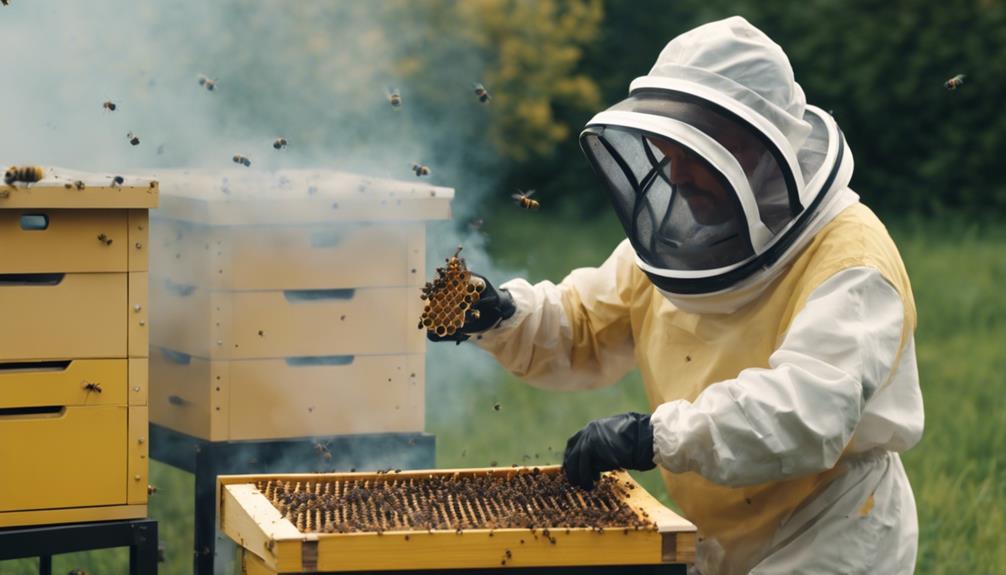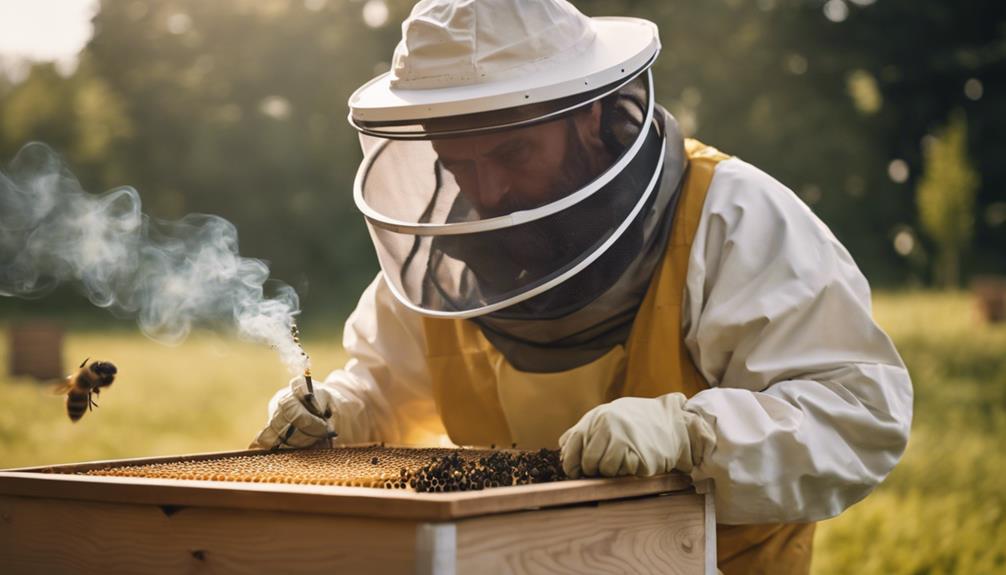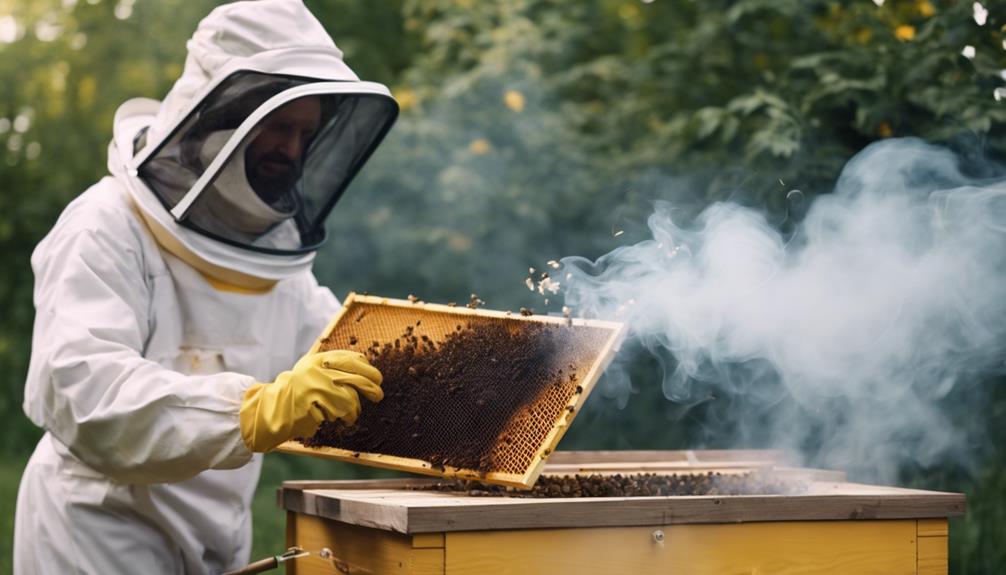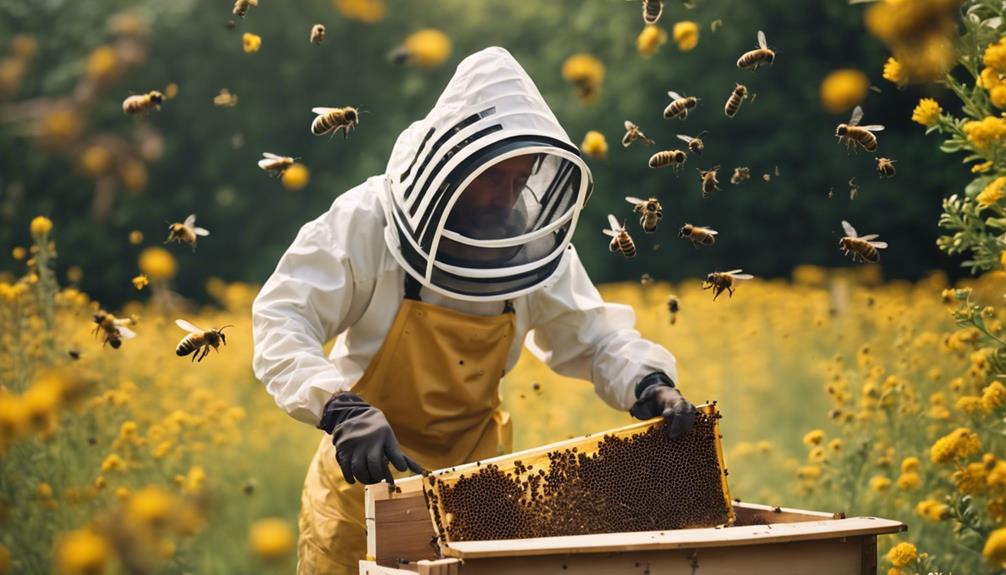Bee smokers are like beekeeper superheroes, swooping in to save the day by calming our buzzing buddies during hive check-ups. By puffing out cool, white smoke, they help mask any "danger, danger" signals bees might send out, turning potential stingers into honey-sipping pals. It’s all about creating a zen zone for both us and our honey-making pals, making sure inspections go smoothly. And hey, if you’re curious about how else these trusty tools keep beekeepers and bees safe, stick around to uncover more hive-saving secrets.
Main Points
- Masks alarm pheromones, reducing defensive behavior.
- Signals potential fire, prompting bees to engorge on honey.
- Decreases likelihood of stinging by calming bees.
- Disrupts communication, creating a controlled environment.
- Essential for safe hive handling and reduced risk.
Importance of Bee Smokers
Using bee smokers is crucial for beekeepers to guarantee their safety and productivity during hive inspections. Concerning smoker fuel, we’ve a few options that can get the job done effectively. Dry leaves, pine needles, or even burlap sacking are popular choices. These materials create a cool, white smoke that helps calm the bees without causing harm.
Remember, the goal isn’t to smoke the bees out but to gently nudge them into a state of tranquility. By grasping the importance of choosing the right smoker fuel, beekeepers can secure a smooth and successful hive inspection experience.
Bee Smoker Benefits
When considering beekeeping tools, the bee smoker stands out for its invaluable benefits in ensuring beekeepers’ safety and fostering a harmonious relationship with bees.
Bee smokers play an essential role in calming bees by masking alarm pheromones, which helps reduce defensive responses during hive inspections. This signaling effect of smoke also prompts bees to engorge on honey instead of stinging, making them more docile and aiding beekeepers in working safely with minimal bee mortality.
The use of a bee smoker is vital for reducing aggression in bees, ultimately enhancing safety for both beekeepers and bees during hive management.
Investing in a bee smoker isn’t just a choice but a necessity to protect oneself and maintain a peaceful coexistence with these incredible pollinators.
How Smoke Affects Bees

When smoke enters a beehive, it triggers a fascinating cascade of reactions among the resident bees.
The bees mistake the smoke for a forest fire and begin preparing to evacuate by consuming extra honey.
This behavior, fueled by their instinct to survive, ultimately helps keep both the bees and beekeepers safe during hive inspections.
Bee Behavior and Smoke
Smoke in beekeeping affects bees by masking their alarm pheromones, preventing defensive reactions during hive inspections. When bees sense smoke, they interpret it as a signal of a fire, triggering them to engorge on honey in preparation to potentially abandon the hive. The disruption of communication caused by smoke makes bees less likely to sting or exhibit aggressive behavior.
Here’s how smoke influences bee behavior:
- Masks alarm pheromones.
- Signals a potential fire.
- Prompts bees to engorge on honey.
- Decreases likelihood of stinging.
Smoke Calms Bees
Using smoke in beekeeping operations has a vital effect on bees, disrupting their communication and reducing the likelihood of defensive behavior. When we introduce smoke, like that from burning pine needles, it interferes with the bees’ ability to release alarm pheromones, the signals that trigger aggression.
Instead of preparing to defend their hive, the bees become engrossed in consuming honey, a behavior that keeps them occupied and less likely to sting. This important effect is essential for beekeepers, as it allows us to work around the hives with reduced risk of provoking aggressive responses from the bees.
Beekeeper Safety Measures
The use of smoke in beekeeping operations improves beekeeper safety by reducing defensive behavior in bees during hive inspections. When we employ smoke, we establish a more relaxed environment for both the bees and us. Here’s how smoke boosts beekeeper safety:
- Masks Alarm Pheromones: Smoke helps conceal the alarm pheromones released by bees, decreasing the likelihood of aggressive behavior.
- Disrupts Communication: By interrupting communication among bees, smoke prevents coordinated attacks on the beekeeper.
- Stimulates Honey Consumption: The use of a bee smoker prompts bees to consume honey, making them less likely to sting.
- Promotes Relaxation: Beekeepers can safely work in hives without triggering aggressive responses, creating a more controlled environment for hive management.
Incorporating stainless steel equipment further elevates our safety during beekeeping activities.
Using Smoke for Beekeeping

During hive inspections, beekeepers rely on the strategic application of smoke to ensure a smooth and safe interaction with the bee colony. When the smoker is lit, it plays a vital role in beekeeping by masking bees’ alarm pheromones, which helps prevent defensive reactions.
By puffing smoke into the hives, bees tend to engorge on honey, making them less likely to sting beekeepers. This disruption in communication among the bees causes them to focus on consuming honey rather than getting agitated. Ultimately, using smoke in beekeeping not only minimizes bee mortality but also improves the overall safety of both beekeepers and bees.
It’s a fascinating technique that allows us to work efficiently and effectively while ensuring the well-being of these incredible pollinators.
Beekeeper Safety With Smokers
Using smokers in beekeeping is like having a superpower against bee stings. The smoke calms the bees, masking their alarm signals, and shields us from their defensive instincts.
It’s like a force field that keeps us safe while we work with these incredible insects.
Smoke Calms Bees
In beekeeping, smoke serves as an essential tool for calming bees, enhancing safety for both beekeepers and the hive.
- Masking Alarm Pheromones: Smoke masks the bees’ alarm pheromones, reducing the risk of defensive behavior during hive inspections.
- Reduced Sting Risk: Calmed bees are less likely to sting, providing a safer environment for beekeepers to work around the hive.
- Initiating Feeding Response: Beekeepers use smoke to initiate a feeding response in bees, further distracting them from aggressive behavior.
- Increased Docility: The calming effect of smoke makes bees more docile and easier to handle, minimizing the chances of stings.
Mask Bee Alarm
We can appreciate how bee smokers play an essential role in beekeeper safety by effectively masking bees’ alarm pheromones. When we light up those bee smokers, we’re not just sending out cool puffs of smoke; we’re actually creating a protective shield around us.
By disguising the alarm signals that bees use to alert their buddies of danger, we’re able to peacefully go about our hive inspections and frame handling without setting off a bee riot. It’s like giving the bees a little smokescreen so they stay chill and don’t feel the need to defend their turf.
Thanks to these trusty bee smokers, we can work harmoniously with our buzzing friends and minimize the chances of unwelcome stings.
Protects Beekeeper From Stings
Masking alarm pheromones with bee smokers improves beekeeper safety by reducing the risk of stings during hive inspections and frame handling. Bee smokers play an essential role in keeping beekeepers protected, allowing them to work confidently with their hives.
Here’s why bee smokers are a beekeeper’s best friend:
- Calming Effect: The smoke from bee smokers helps to soothe the bees, making them less likely to feel threatened and sting.
- Distraction Technique: Bee smokers prompt bees to engorge on honey, diverting their attention away from the beekeeper and reducing the chances of stings.
- Enhanced Safety: With bee smokers, beekeepers can navigate hive inspections more securely, minimizing the risk of bee stings.
- Efficient Hive Handling: Bee smokers enable beekeepers to manage hives effectively and efficiently, creating a safer working environment for all involved.
Types of Bee Smoker Fuel
When selecting fuel for a bee smoker, beekeepers should prioritize natural materials like burlap, pine needles, wood pellets, twigs, or cardboard over synthetic options. Pine needles, in particular, are excellent for generating cool, thick smoke that calms the bees without overheating the hive. These natural materials burn slowly, light quickly, and provide a steady stream of smoke, making them ideal for beekeeping tasks.
Avoid using synthetic materials or bleached paper, as they can release harmful chemicals when burned. It’s convenient that free smoker fuel can often be found at home or nearby, ensuring beekeepers always have a readily available supply. Having the right kind of fuel ready is essential for maintaining a peaceful and productive beekeeping environment.
Techniques for Smoking Hives

To effectively calm bees and manage hive behavior, beekeepers must master essential smoking techniques. When smoking hives, remember these key points:
- Puff at the Entrance: Before opening the hive, puff some smoke at the entrance to signal vital and prevent defensive reactions.
- Quality Fuel Matters: Use slow-burning, high-quality fuel in the smoker to guarantee a consistent smoke output for better hive management.
- Moderation is Key: Apply smoke in moderation to prevent overwhelming the bees and disrupting their environment.
- Target Agitation: Direct smoke towards areas where bees are agitated or stinging to discourage further aggression.
These smoking techniques are essential for beekeepers to safely and effectively handle their hives while maintaining a harmonious relationship with their buzzing friends.
Maintaining Bee Smoker Equipment
Regularly cleaning the bee smoker is essential to maintain its performance and guarantee effective hive management. It’s like giving your dependable beekeeping sidekick a spa day! Removing the accumulation of soot and debris ensures that the smoke output remains consistent during hive inspections.
Don’t forget to check the bellow and nozzle to keep that airflow smooth and steady. Just like tuning up a musical instrument, these small checks can make a significant difference in how well your bee smoker performs.
And speaking of performance, remember to replace the fuel when needed to keep that smoke swirling. Storing your bee smoker in a dry place is critical to prevent rust and keep it in top shape.
Regular maintenance checks will help you catch any issues early on, making sure you’re always ready for a buzzing beekeeping adventure!
Enhancing Beekeeping Practices

Improving beekeeping practices involves utilizing bee smokers to foster safety and efficiency during hive inspections. Here are four ways bee smokers elevate beekeeping practices:
- Key Effect: Bee smokers help keep bees calm and reduce defensive responses, making hive inspections safer for beekeepers.
- Decreased Mortality: The use of smoke minimizes bee mortality and aggression, creating a safer environment for both bees and beekeepers.
- Docility Promotion: By masking attack pheromones and encouraging bees to engorge on honey, bee smokers make bees more docile and less likely to sting.
- Efficiency Boost: Bee smokers play a vital role in promoting efficient beekeeping practices, ensuring a harmonious relationship between beekeepers and bees. This approach resonates with the principles advocated by beekeeping pioneer Moses Quinby.

Roger Thomas is a seasoned beekeeper and hive architect with a deep-seated passion for sustainable living. His fascination with bees has shaped his professional career, giving him practical and theoretical expertise in bee behavior, colony health, and optimal hive conditions. Roger’s technical skills shine in his bespoke hive creations that cater to the specific needs of diverse bee species, while his sustainable practices promote environmental balance and the wellbeing of the bee population.
As he continues his journey in beekeeping, Roger has become a dedicated advocate for responsible practices and an insightful educator in his field. His posts aim to inspire new beekeepers, underline the importance of sustainability, and showcase the remarkable contribution bees make to our ecosystem. Roger invites you to join him as he delves into the world of bees and the rewarding, honey-sweet art of beekeeping.


